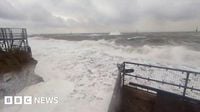Britain has been battered by a barrage of wild weather this week, as Storm Benjamin made landfall, bringing heavy rain, howling winds, and a rapid plunge into wintry conditions. The Met Office, the UK’s official weather agency, issued four yellow weather warnings for Thursday, October 23, 2025, spanning much of England and parts of Wales. These warnings, according to ITV News, were prompted by the looming threat of flooding, power cuts, and major travel disruption as the storm swept eastward from the English Channel towards the North Sea.
Rainfall was relentless, with 20-30mm expected widely and some places bracing for 30-50mm in a matter of hours. The warnings covered a broad swathe of the country: East Midlands, East of England, London & South East, North East England, South West England, West Midlands, Yorkshire & Humber, and Wales. The Met Office cautioned that gusts of 50-60 mph were probable across these areas, with coastal regions facing the risk of 65-70 mph winds—and, in a worst-case scenario, gusts exceeding 70 mph could have developed locally during the late morning and afternoon. Cornwall, Devon, and the west coast of Wales were also under a yellow wind warning, with widespread gusts up to 45 mph.
“It is worth noting that there is a greater than usual uncertainty surrounding the track and intensity of this low-pressure system,” explained Chief Meteorologist Rebekah Hicks of the Met Office. “The public should stay up to date with the latest forecasts and warnings as the situation evolves, with adjustments to the forecasts likely at short notice.”
As the storm’s core barreled northeast, the UK found itself in what meteorologists call Storm Benjamin’s “backwash.” This phenomenon, described by National World, meant another round of rain for the east of England and a shift in wind direction that would draw in cold, arctic air from the north. The result? A sharp drop in temperatures and a biting chill that signaled the first taste of winter for many Britons.
By Friday, October 24, 2025, the Met Office was warning of a “sharp temperature drop” and urging people to prepare for sleet and snow, especially in Scotland and northern regions over the coming weekend. As reported by Eastern Eye, “cold arctic air” was poised to sweep across the country, causing temperatures to tumble and brisk winds to make it feel even colder. Eastern coastal areas were expected to bear the brunt of these winds and showers, while inland regions faced a mix of rain and overnight frost.
There was a “reasonable chance” of sleet and snow across northern areas—particularly over the Scottish Highlands and Grampians—overnight on Saturday, October 25. The Met Office forecast snow and hail for parts of Scotland, with temperatures across the UK stuck in single digits: highs of 11°C in England, 10°C in Wales, and around 8°C in Scotland and Northern Ireland. Rural areas were likely to see the mercury dip close to freezing, and even some towns and cities could wake up to a widespread frost on Saturday morning.
GB News added another layer to the chill, reporting that an “Arctic plunge” was sending temperatures tumbling to -5°C in some spots as polar winds swept in behind Storm Benjamin. This sudden shift was all the more dramatic given that the UK had enjoyed highs above 15°C earlier in the season—a balmy spell now replaced by what forecasters called a “bitter early taste of winter.”
Looking ahead, Sunday, October 26, was forecast to start frosty again before a new weather front was expected to move in from the northwest, bringing cloud, rain, and slightly milder air. Still, the Met Office didn’t expect any sleet or snow to be heavy or disruptive, but it did warn those heading to hills or mountains to be prepared for wintry conditions. “While any sleet or snow is unlikely to be heavy or disruptive, it is not unusual for this time of year,” the agency noted. “Those heading to the hills or mountains should be prepared.”
The early part of the following week was expected to remain unsettled, with a mix of wet and dry spells and temperatures still on the chilly side. As National World described, there was “uncertainty about the timing and extent” of the new weather system, and some models suggested rain could arrive sooner than others. By midweek, however, there was hope for a transition to quieter weather, particularly in the south, as higher pressure tried to build in.
Storm Benjamin wasn’t just a UK phenomenon. The Guardian reported that the same deep Atlantic low-pressure system wreaked havoc across northern France, where coastal gusts reached 70 mph, more than 100,000 homes lost power, and rainfall totals soared to 40mm in just 24 hours. Earlier in the week, a tornado swept through Val-d’Oise, north of Paris, toppling construction cranes, damaging buildings, and uprooting trees. Tragically, one person was killed and four others were critically injured. The UK wasn’t spared from tornado drama either: heavy showers hit parts of Norfolk, with reports of a possible tornado damaging homes in Dereham, though thankfully no injuries were reported.
Elsewhere in the world, weather extremes continued. Australia grappled with ferocious winds and record-breaking October heat, while the Caribbean braced for Tropical Storm Melissa, the 13th named storm of the season, and South Africa sweltered in temperatures well above seasonal norms. But for Britons, the focus remained close to home: how to cope with the sudden swing from autumnal mildness to winter’s icy grip.
For now, the advice from forecasters is simple: keep a close eye on the latest updates, dress warmly, and be prepared for rapidly changing conditions. Whether it’s the threat of flooding, a sudden frost, or even a dusting of snow on the hills, it’s clear that the UK’s weather has well and truly turned a corner into the colder months.


